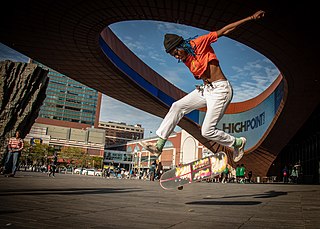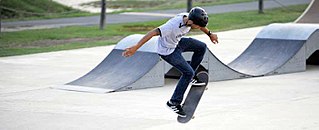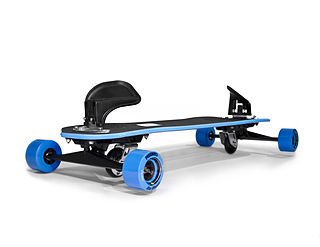
Skateboarding is an action sport that involves riding and performing tricks using a skateboard, as well as a recreational activity, an art form, an entertainment industry job, and a method of transportation. Originating in the United States, skateboarding has been shaped and influenced by many skateboarders throughout the years. A 2009 report found that the skateboarding market is worth an estimated $4.8 billion in annual revenue, with 11.08 million active skateboarders in the world. In 2016, it was announced that skateboarding would be represented at the 2020 Summer Olympics in Tokyo, for both male and female teams.

A skateboarding trick, or simply a trick, is a maneuver performed by manipulating a skateboard, usually with one's feet, in a specific way to achieve the desired outcome – the trick.

The kickflip is a skateboarding trick, in which the rider flips their skateboard 360° along the axis that extends from the nose to the tail of the deck. When the rider is regular footed the board spins counter-clockwise if viewed from the side.

Longboarding is a variation of skateboarding typified by the use of longer boards ("decks") with longer wheelbases and softer wheels. While longboards vary widely in shape and size, compared to street skateboards longboards are designed to be more stable at speed and to have more traction due to larger wheel sizes and softer wheel durometers. While standard street skateboards may typically be between 28 to 34 inches long, longboards can range anywhere from 32 to 50 inches in length. Ride characteristics of longboards generally differ from that of street skateboards due to the use of specialized longboard trucks that have different properties than those typically used with skateboards; while street skateboards use "traditional kingpin" (TKP) trucks that are optimized for tight turning radii, ollie and flip tricks, slides, grinds, and transition skating, longboards are typically paired with "reverse kingpin" (RKP) trucks that are designed for increased stability at higher speeds, more "surfy" carving characteristics, and/or greater ride comfort for commuting over longer distances.

Tony Hawk's Underground is a 2003 skateboarding video game and the fifth entry in the Tony Hawk's series after Tony Hawk's Pro Skater 4. It was developed by Neversoft and published by Activision in 2003 for the GameCube, PlayStation 2, Xbox, and Game Boy Advance. In 2004, it was published for Microsoft Windows in Australia and New Zealand as a budget release.

The ollie is a skateboarding trick where the rider and board leap into the air without the use of the rider's hands. It is the combination of stomping, also known as popping, the tail of the skateboard off the ground to get the board mostly vertical, jumping, and sliding the front foot forward to level out the skateboard at the peak of the jump.
In human biology, footedness is the natural preference of one's left or right foot for various purposes. It is the foot equivalent of handedness. While purposes vary, such as applying the greatest force in a certain foot to complete the action of kick as opposed to stomping, footedness is most commonly associated with the preference of a particular foot in the leading position while engaging in foot- or kicking-related sports, such as association football and kickboxing. A person may thus be left-footed, right-footed or ambipedal.

A bertslide, Bertlemann slide, or bert, is a skateboarding trick where the skateboarder puts one hand on the ground and rotates the board while it is still on the ground, effectively sliding on the wheels of the skateboard. The trick was named after the surfer Larry Bertlemann, who first performed the trick on a surfboard, then later incorporated it into his skateboarding. The original version of the trick was a 180-degree turn. The Z-Boys, an influential group of mid-1970s skateboarders, adapted the move by extending the slide to 360 or even 540 degrees.
In surfing, skateboarding, snowboarding and aggressive inline skating, frontside and backside are terms that are used to describe how a person approaches an obstacle or performs a certain trick. In aggressive inline skating, frontside and backside are types of grinds.
Casper is a freestyle skateboarding trick that was invented by Bobby "Casper" Boyden in the late 1970s. Boyden had a very pale skin and he was nicknamed after the cartoon ghost. The modern casper was invented by Rodney Mullen in the late 1980s.

Freestyle BMX is bicycle motocross stunt riding on BMX bikes. It is an extreme sport descended from BMX racing that consists of five disciplines: street, park, vert, trails, and flatland. In June 2017, the International Olympic Committee announced that freestyle park was to be added as an Olympic event to the 2020 Summer Olympics.

Mike McGill is an American skateboarder who is best known for inventing the trick entitled the "McTwist", an inverted 540 degree mute grab aerial.
A freestyle skateboarding trick is a trick performed with a skateboard while freestyle skateboarding. Some of these tricks are done in a stationary position, unlike many other skateboarding tricks. The keys to a good freestyle contest run are variety, difficulty, fluidity, and creativity. This is an incomplete list, which includes most notable tricks.
A flip trick is a type of skateboarding trick in which the skateboard rotates around its vertical axis, or its vertical axis and its horizontal axis simultaneously. The first flip trick, called a kickflip but originally known as a "magic flip", was invented by professional skateboarder Rodney Mullen.

In skateboarding, grinds are tricks that involve the skateboarder sliding along a surface, making contact with the trucks of the skateboard. Grinds can be performed on any object narrow enough to fit between wheels and are performed on curbs, rails, the coping of a skate ramp, funboxes, ledges, and a variety of other surfaces.

A slide is a skateboarding trick where the skateboarder slides sideways either on the deck or the trucks.
SKATE, also known as the Game of Skate, is a skateboarding game where skaters attempt to perform each other's tricks in succession until all but one player is eliminated. It uses rules based upon the H.O.R.S.E. game played by basketball players. SKATE was first played in the 1970s by vertical skateboarders Lance Mountain, Neil Blender and John Lucero, and was then adopted by street skaters in the 1980s. In January, 2003 Eric Koston's éS Game of SKATE a professional invitational event, was held, and was the first tournament-style, head-to-head format event of its kind. Not long after, K5 Boardshop was the first organized amateur tournament for SKATE. The éS Game of SKATE tournament expanded globally in 2004 and has both professional and amateur divisions.

A freeboard is a specialist skateboard designed to closely simulate the behavior of a snowboard. Freeboards were developed to allow snowboarders to transition to skateboarding without the need to adapt to a smaller deck and narrower wheel-base.

Street skateboarding is a skateboarding discipline which focuses on flat-ground tricks, grinds, slides and aerials within urban environments, and public spaces. Street skateboarders meet, skate, and hang out in and around urban areas referred to as "spots," which are commonly streets, plazas or industrial areas. To add variety and complexity to street skateboarding, obstacles such as handrails, stairs, walls, flower beds, bins, park benches, picnic tables, and other street furniture may be traversed as single tricks or as part of a series of consecutive tricks called a "line."












